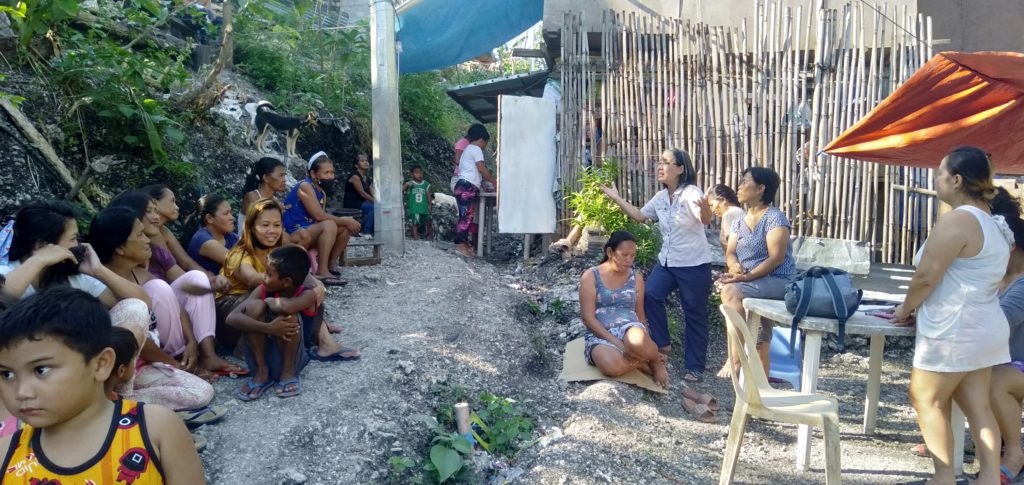March 2008 – December 2010
The partnership between the Visayas Primary Health Care Services, Inc. (VPHCS) and the Asmae- Association Soeur Emmanuelle spanned the period March 2008 – December 2010. It was a very fruitful partnership that benefitted tremendously the residents of three urban poor communities in Metro Cebu, namely: Sitio St. Mary Grace in Barangay Talamban, Cebu City, Sitio Back of Matimco in Barangay Subangdaku, Mandaue City, and Sitio Salvage in Barangay Looc, Lapu-lapu City.
The VPHCS also reaped huge gains in terms of organizational strengthening and capability building to pursue its programs and services in a more systematic, effective and efficient manner.
One project evolved into the second and then into the third. The first project, “Capability Building on Community-based Health Programs in Cebu: Community Diagnosis” in March 2008 to August 2008 was followed by the second project “Promotion of Environmental Health and Child Nutrition in Community-based Health Programs in Cebu and Strengthening the Sustainability Aspect of the VPHCS” in April 2009 to December 2009 and the viagra coupons third project, “Strengthening and Sustaining the Community-based Health Programs in Cebu” in January 2010 to December 2010.”
Contact with Asmae was first established with Beatrice GALONNIER, ASMAE Nurse Volunteer who volunteered in one of the medical missions of the VPHCS in Barangay Montesuerte, Carmen, Bohol on April 14, 2007 after being invited by a VPHCS staff member in Bohol who was her friend. She went to the VPHCS office in Cebu and introduced the management committee to Jeanne MARTIN, then Visayas-Mindanao coordinator. A partnership with VPHCS was established with Asmae through Ms. MARTIN and the first project was born.
Generally, the whole project is part and parcel of the community-based health programs (CBHP) building endeavors of the VPHCS for the past several years.
Such mission of the VPHCS was born based on the reality of the prevalence of many common diseases that could otherwise be prevented and treated easily. Such diseases like pneumonia, diarrhea, measles and tuberculosis have consistently been the top leading causes of mortality in the local and national levels. This could be contributed by factors such as the lack of capacity, knowledge and skills of the people in the primary level to prevent such diseases, and the lack of resources to avail of secondary and tertiary care.
The experience of the VPHCS has proven that these common health problems can readily be managed by community health workers (CHWs) who are equipped and knowledgeable on basic preventive and promotive health care. Such trained CHWs can very well complement understaffed local health centers and barangay health workers.
The strategy of building local capacity in health employed since decades ago by a consortium of CBHPs in the Philippines of which the VPHCS is a member, has recently been adopted even in non-health government and non-government programs involving local and national agencies and multilateral organizations.
Building and strengthening local capacity has become more urgent with the advent of the national and global trend on health which emphasizes user-fee services and privatization of government health service agencies in the face of the people’s worsening poverty that severely incapacitates them to pay for health care.
The VPHCS has always worked with people’s organizations and their health committees in its health endeavors. At the core of the health committees are community health workers (CHWs) who are trained to provide basic health services to the families under their care, render health education, prepare herbal medicines, encourage residents to participate in community activities on health, bring patients to clinics or hospitals and facilitate community meetings to discuss relevant issues.
In this project, the three communities were selected after consultations were made with people’s organizations in Metro Cebu in early part of 2008. These include the St. Mary Grace Neighborhood Association in Barangay Talamban, Cebu City, the Kaming Lumulupyo walay Sandigan (KALUWASAN) in Sitio Back of Matimco, Barangay Subangdaku in Mandaue City and the Anakpawis – Looc Chapter in Sitio Salvage, Barangay Looc, Lapu-lapu City. The leaders of the farmer’s organizations looked forward and expressed their support to the project that shall equip them and their CHWs with essential knowledge and skills to build CBHPs which shall address the common health problems in their communities.
Community participation and involvement in designing and implementing the health programs is a hallmark in CBHPs and is the cornerstone in the primary health care approach of health service delivery. Thus, throughout the project, the communities through their people’s organizations were always involved in the planning and implementation of their health programs that concretely addressed the problems identified in the community diagnosis that was made in the first project. Thus, there was a spirit of zeal and a sense of responsibility, open enthusiasm and utmost interest among the people that contributed greatly to the success of the project.



